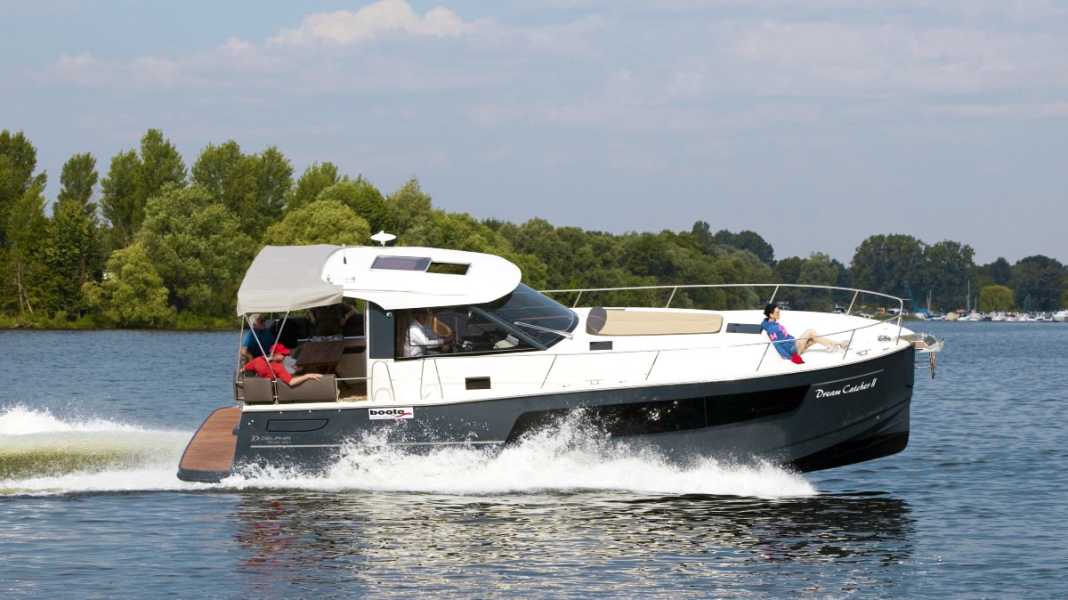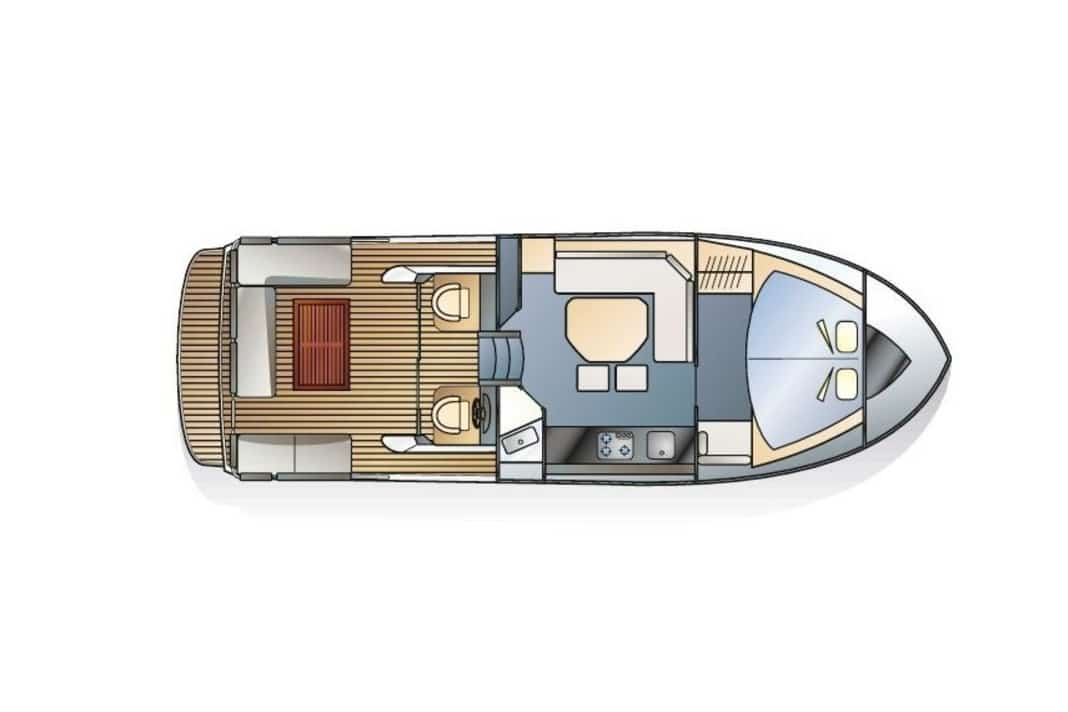
The last Delphias we travelled with had rather low engine power. A characteristic that the German importer Ben Weidner from Werderaner Yachthandel chose quite deliberately, as his sales and charter centre is located, as the name suggests, in Werder an der Havel.
The Delphia Escape 1100 S is certified with CE category B (outside coastal waters).
Speed limits of between 5 and 12 km/h usually apply on the waters around Berlin, which means that little engine power is required. However, customers who want to sail the Baltic and North Sea or fast-flowing rivers are now also coming to him. For the latter in particular, half-gliding at around 25 km/h or more is an advantage.
Our test boat, the Delphia Escape 1100 S, performs even better, travelling at a maximum speed of 54 km/h. If you want to glide economically, the skipper has to reduce the speed by around 10 km/h, the two Volvo diesels revolve at around 3500 rpm, and around 1.5 litres/km run through the fuel lines. The 600-litre tank is then sufficient for a respectable 412 km.
One tank of petrol plus the obligatory 15 % reserve is sufficient for 1000 km, even at a displacement speed of around 14 km/h.
At slow speeds, the Delphia holds its course well after a short levelling phase, and the weight shifting of three adults does not cause it to go off course. From around 1800 rpm, the bow lifts up and lowers again automatically at around 3400 rpm, which noticeably improves foresight.
The driver simply raises the power trim a little (-2 on the display) and, when trimmed in this way, can take any fast turn without the propeller snapping or the fuselage hooking in tight radii. The fuselage reacts safely and directly to the smooth steering during these manoeuvres, as well as when the steering is twisted and on somersault courses.
Narrow berths can be easily reached thanks to the good manoeuvrability of the twin engine system and the bow thruster. Everything is operated from the wheelhouse.
The bucket seat provides the driver with good lateral support, but you have to get used to the bulging seat surface at the front (which can be folded up). Standing up straight is uncomfortable for the 1.80 metre tall driver, as there is not enough headroom.
It is better if the front seat section is folded up and you sit on it. From there, the helmsman has a good all-round view, and in rainy weather a sturdy double-arm wiper ensures a clear view forwards through the lightly tinted safety glass window. With a few exceptions, the shipyard has organised the dashboard in a practical way. The standard equipment with compass and chart plotter is particularly praised.
Riding: In fast bends, the Delphia does not lean excessively on its side and pulls its laps smoothly without hooking or rocking. The power trim setting plays no role here.
The engines are located under a floor hatch in the cockpit, which opens very easily at the touch of a button. The service technician has plenty of space to work underneath and does not lose track of things, as all cables are neatly bundled and firmly laid. The fuelling and electrical systems, which are expertly equipped with two main switches per network (1 x electronic, 1 x manual emergency operation), also give a good impression.
The combination of fire extinguishing system and incombustible sound insulation also provides a high level of safety. The same applies to the equipment with electric bilge and hand bilge pumps. Railings, appropriately positioned handrails and non-slip floor structures ensure safe movement. The only drawback: there is a water-repellent strip on the side deck that can be tripped over.
To ensure that "water rats" can get in and out of the water without restriction, Delphia has provided a three-step ladder that is also easy to use from the water.
A stern door separates the bathing platform from the cockpit in an exemplary manner, and further towards the bow the saloon is accessed via the wheelhouse and companionway. There, not only is there space for the deckhand at a well-equipped galley, but also a seating area for the entire crew with an L-shaped sofa, free-standing stove and wooden table for eating and socialising.
Sleeping is on double berths in the bow and mid-cabin, whereby the berth in the centre is noticeably narrower than the one in the foredeck (2.07 x 1.95 m). Praise for both: the under-ventilation of the mattresses. Both cabins and the wet room offer plenty of storage space in cupboards, shelves and lockers.
With the exception of a plastic edge (from the driving position floor), which interferes with the shoulder area (1.80 m tall person) when sitting on the toilet, the room with shower (pull-out hose on the washbasin and floor drain) has a practical layout. The headroom below deck varies between 1.84 m and 1.90 m, in the passageway by the wheelhouse it is 2.02 m, under the canopy 2.11 m.
The Delphia is moored to six solid cleats and the lines are passed through eight cleats. Fenders are attached to the railing and tubular frame, while a sufficiently large, all-round rubbing strake provides protection in the event of small bumps. The additional mouldings in the stern area are really solid. With a few exceptions, such as one or two gaps in the furniture or unclean silicone seams, the workmanship makes a decent impression.
Our conclusion
The Delphia Escape 1100 S is a comfortable cruising boat for four people. Thanks to its powerful motorisation, it is also well suited for the sea and fast rivers. It has plenty of standard equipment and, with a few exceptions, is attractively finished and carefully installed.







